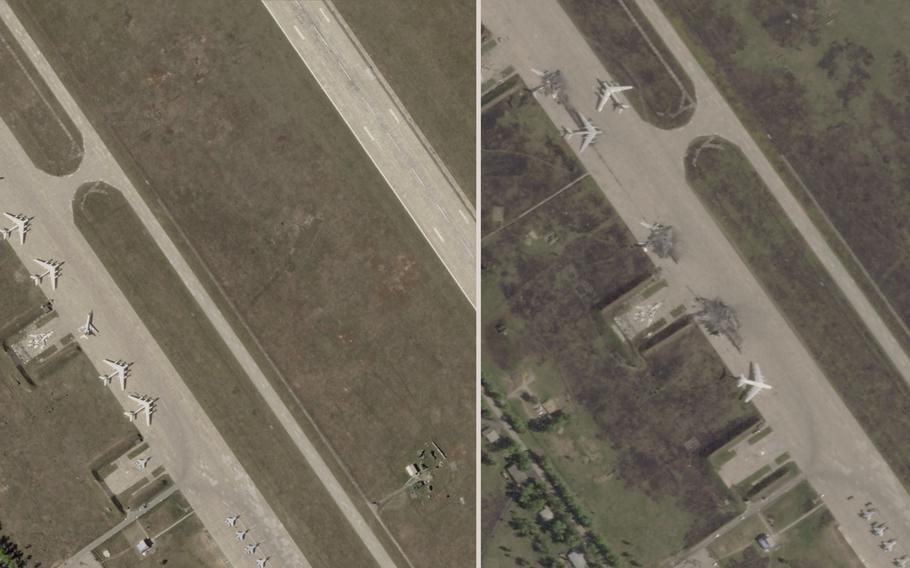
This photo combo from satellite images from Planet Labs PBC shows from left, the Belaya Air Base before a Ukrainian drone attack in the Irkutsk region of eastern Siberia in Russia captured on May 17, 2025, and damage after a Ukrainian drone attack captured Wednesday, June 4, 2025. (Planet Labs PBC )
KYIV, Ukraine — For one year, six months and nine days, Ukraine’s intelligence service carefully plotted, designed and built special drones, concealed in prefabricated mobile homes that were then transported across borders to strike an surprising blow thousands of miles away against Russia’s strategic bomber fleet.
Intelligence chief Vasyl Maliuk revealed to journalists new details of “Operation Spiderweb” in a two-hour conversation on Sunday about the plan to attack Russia’s air bases that crippled several long-range bombers and rewrote the rules for drone warfare.
Ukrainian security officials have said the June 1 attack destroyed 12 Russian aircraft, including the Tu-95 long-range bombers that the Kremlin uses to target Ukrainian cities with missiles, and hit 41 aircraft in total.
Satellite imagery analyzed by The Washington Post indicated that at least 12 aircraft were damaged — some of them 3,400 miles east of Ukraine in Siberia. Some imagery was not available immediately after the attack because of cloud cover, and it is possible some wreckage was cleared away.
“We started doing this in November 2023, because then the enemy once again began to massively shell peaceful Ukrainian cities,” Maliuk said, according to a transcript released by the SBU, as the intelligence service is known, on Monday. “Our task was to destroy missile carriers.”
The drones were concealed under the roofs of prefabricated houses that were transported by truck to locations near the targets to be then released remotely. Since the drones had to stay charged, the houses had to have their own power systems.
The houses were equipped with solar panels and special batteries, which would “constantly power the drones,” even in cold temperatures on the chance the operation would take place in the winter.
Because Russian authorities had barred items such as solar panels and those batteries from entering their country, the homes and their cargoes faced some issues at customs entering the country. “We were forced to bribe Russian customs agents,” Maliuk said.
Each person involved on the project worked on a need-to-know basis. “The people who made the drones did not know that they were for Spiderweb. The people who made the houses did not know that these would be for aerial vehicles. … Each was responsible for his own extremely important, separate direction of work,” he said.
Maliuk said he selected the “best drone operators” for the actual attack on the airfields as the roofs of the mobile homes opened up and the drones flew out to locate their targets. On the day of the attack, the operators gathered at the command control point at 5 a.m.
“Their phones were taken away,” he said. “And the work began: Each was given a target [and] a specific plane was ‘allocated.’ Each had a model of the terrain … the location of the houses, the route, how to fly there.”
He said the 117 drones used were the familiar first-person view or FPV drones that wreak so much havoc on the battlefields, but they were equipped with a unique double warhead. The first 1½-pound charge was to penetrate the skin of the aircraft, allowing the second charge to explode inside.
The operators controlled the drones through “several types of communication,” but Maliuk declined to go into detail about the technology.
The drones targeted fuel tanks, the sides of the aircraft from where missiles were launched and the delicate avionics “that the enemy does not have in reserve.”
Two days after Spiderweb, Ukraine attacked the Kerch Bridge that connects Russia to the Crimean Peninsula — which Russia annexed illegally from Ukraine in 2014. Maliuk said the attack involved two explosives of nearly 2,500 pounds, instead of one as was originally reported, which were detonated underwater.
Traffic on the bridge was only temporarily suspended, however, Russian officials said.
Russia’s response was not long in coming. Three days after the Kerch attack, it launched hundreds of drones and dozens of cruise and ballistic missiles across Ukraine in what it said was retaliation. Kyiv bore the brunt of the attack, with at least three people killed and 20 injured.
Despite the audacious nature of the drone attack and its success in hitting Russia’s bomber fleet, the aerial attacks against Ukraine have not abated; if anything they have been on the rise throughout June.
Russian forces have regularly pounded Ukrainian cities in recent weeks, with the latest attack taking place Monday. A residential building collapsed because of a strike, with at least nine people killed, coming just a week after another building collapse in Kyiv killed at least 23.
Maliuk said that Spiderweb was just a small demonstration of the SBU’s capabilities and that the operation showed “it is capable of nonstandard solutions that change the history of warfare.”
“This is the tip of the iceberg in our work with logistics, drones and agents,” Maliuk said. “In Spiderweb, everything was brought together into a single whole.”
Anastacia Galouchka contributed to this report.